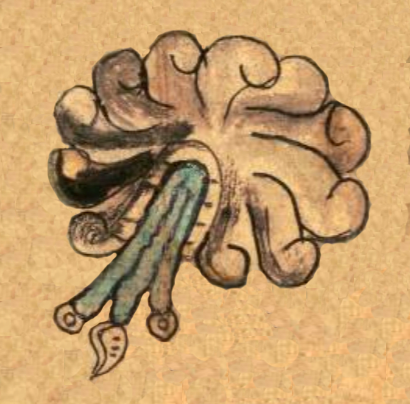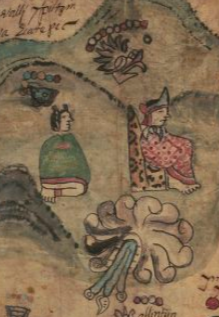ameyalli (CQ)
This simplex glyph for a natural spring (ameyalli) shows a triple stream of water (painted turquoise and spewing white turbinate shells and white water droplets/beads) emerging from a cave or white stone archway. Swirling above and around the cave opening may be more water, or perhaps steam or smoke, given that it is white, gray, and black, with tinges of pink.
Stephanie Wood
This simplex glyph may actually be a compound glyph for ameyalli iztac ("manantial blanca" in Spanish). In fact it does not have a gloss to identify it as an ameyalli. We are naming it an ameyalli based on an article by Sebastián van Doesburg (see the Bibliography) that identifies it from another manuscript as the manantial blanca and "una fuente de agua dulce" (a fountain of fresh water) on the hill where Quetzalecatzin and Chicome Tochtli (his wife) established their ruling house (tecpancalli), killing then ruler Ehcatl (or Ehecatl) in the year Matlactli Once Acatl (Eleven Reed). The location of this spring was in Tecamachalco.
Stephanie Wood
covers ruling men and women of Tecamachalco through 1593
Stephanie Wood
springs, manantiales, water, agua, white, blanco, xiuhpohualli, año, turquesa, xihuitl

manantial natural
Ofelia Cruz Morales
The Codex Quetzalecatzin, aka Mapa de Ecatepec-Huitziltepec, Codex Ehecatepec-Huitziltepec, or Charles Ratton Codex. Library of Congress. https://www.loc.gov/item/2017590521/
The Library of Congress, current custodian of this pictorial Mexican manuscript, hosts a digital version online. It is not copyright protected.



